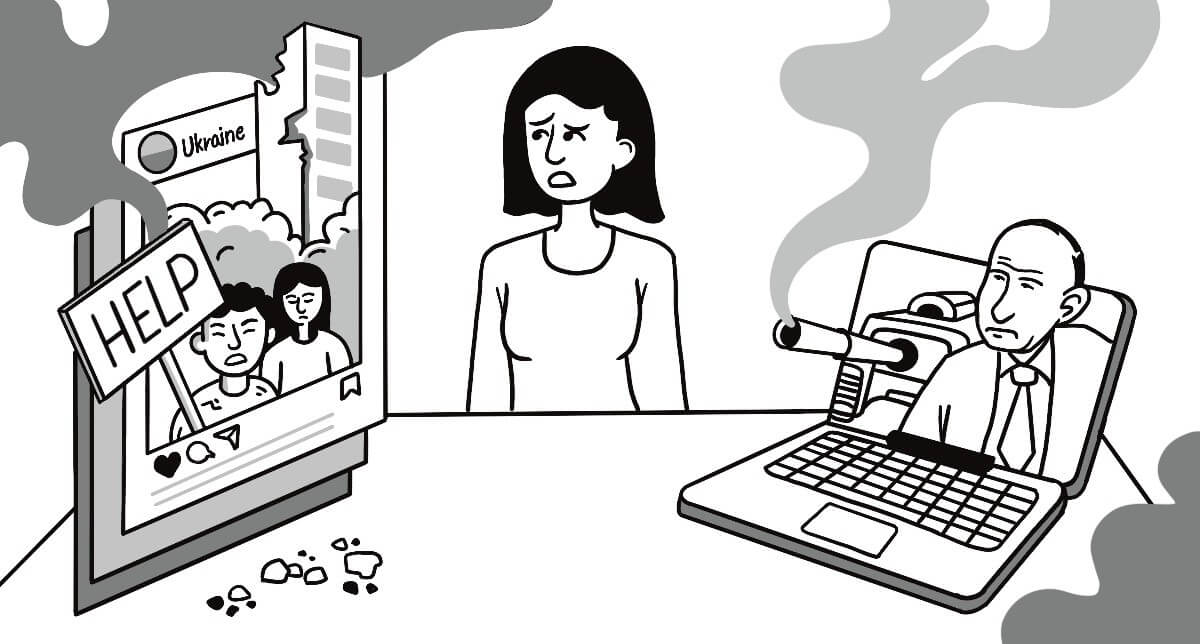For centuries, countries that have started wars or have participated in them have done so by selling a national narrative – a means to justify their actions. From racial and ethnic cleansing to religious and ideological differences, the pages of history are filled with instances of war propaganda. This communications strategy came into place when leaders began to realize the value of ideas in the face of conflict. Without a just cause to back it, violence, bloodshed, and destruction are regarded as nothing short of monstrosity. But when the same weapons are picked up for self-defense or for the greater good of others, it’s considered heroic. Is the morality behind these conflicts really so obvious? Or is there a calculated marketing scheme at play, shaping the way we view violence in one part of the world over another?
In this article, we will discuss the importance of marketing the war propaganda, with a special focus on the current Russia-Ukraine scenario. We will also be looking to the past to study instances of how national policies were ‘sold’ to the rest of the world to substantiate military action.
The marketing elements behind war propaganda
World War I saw the birth of war propaganda, where the government and the mass media came together to shape public opinion on state matters. This was a powerful psychological tool. It could manipulate the public to make them believe what the government wanted them to. From posters, movies, books, and speeches, every element of culture was crafted to influence the collective opinion on the ongoing or upcoming war.
In his book titled Propaganda Technique in the World War, American political scientist Harold Lasswell made an effort to identify the marketing factors in the time of conflict. Pinning the guilt on the enemy, stating clear war aims, villainizing the enemy, and manipulating the public to believe that negative press from the enemy were lies and falsehood, were a few of the factors he theorized. According to a study by Edward L. Bernays, three primary elements shone from the psychological warfare of the Great War
- Heighten the morale-unity of your own country.
- Weaken the morale of your enemy.
- Win over the morale of the neutrals.
In the Nazi Germany of 1941-1945, the Holocaust slaughtered approximately six million Jews, which was roughly two-thirds of the Jewish population in Europe. “Say what you like about Hitler, but he was a passionate man,” says comedian Daniel Sloss in one of his Netflix specials. But a single man’s passion could not have resulted in the mass murders of millions of people – his success lay in his ability to sell and market his ideas to gather the support of millions of others.
How Hitler advertised the Nazi brand
In a 2009 paper titled Selling Hitler: Propaganda and the Nazi Brand, author Nicholas O’Shaughnessy explains how Nazism functioned as a brand. “The integuments of this brand strategy were the idea of Hitler himself and his projection, the stress on solidarity, the proclamation of a modernist Utopia with ancient accents, and the construction of an existential threat to the German way of life,” he says. He further argues that Hitler employed classic marketing ideas like segmentation, targeting, and of course, packaging. Through symbolism and emotion, he built a brand that was and remains, unforgettable.
Let’s take a closer look at how he did this. In 1933, Josef Goebbels was announced as the Minister of Propaganda. It was his job to brainwash the country into believing in Nazi ideology. Hitler was idolized as the savior of Germany, his posters and pictures everywhere for the people to see. Rallies were conducted to glorify the war, and events like the 1936 Berlin Olympics were held to establish the superiority of the Aryan Race. Apart from this, Goebbels had complete control over the media, and censorship of radio, newspapers, books, and movies were imposed. Anything or anyone that didn’t agree with the Nazi brand was silenced.
The situation today
The Russian attack by President Vladimir Putin on Ukraine on 24th February 2022 has been condemned by leaders and citizens all over the world. And yet, Russia continues to bomb and invade Ukraine, Europe’s second-largest country. Putin is marketing the war by claiming
that his country faces a threat from Ukraine, and wishes to demilitarise it. In an attempt to justify his actions, he’s using propaganda to influence Russian opinion. The state controls the media and has forbidden publications and media outlets to use words such as ‘war’, ‘invasion’, and ‘attack’. They also talk about cutting off access to social media platforms such as Facebook and Twitter.
Additionally, the Russian citizens are flooded with propaganda and misinformation. They are told that their country is under threat, that Ukraine is run by drug addicts and Nazis, etc. Despite this, protests have been erupting in Russia and citizens have been expressing their anger and shame.
At the other end of the scale, Ukraine is leveraging the imagery of destruction to gather support from the rest of the world. The Internet is full of powerful images of civilians carrying weapons, emotional reunions of family members, desperation at state borders, and the unity of the Ukrainian people in the face of horror. All of this suggests, as a Firstpost article argues, that Russia may win the Kyiv battle but lose the image war.
In conclusion
Psychological warfare turns countries into brands that rely on war campaigns to gather national and global support, shape public opinion, and attack the enemy’s image and morale. The campaign idea is to establish their cause as right, moral, and just, and pin the blame on their enemy via artful marketing. Much like traditional marketing, countries must rely on promotion and placement to spread their narrative.
I wonder which agency got the mandate for creating Russia’s marketing communications.
There are always two sides to the story. And propaganda, when marketed well, often sells more tickets than the truth.

